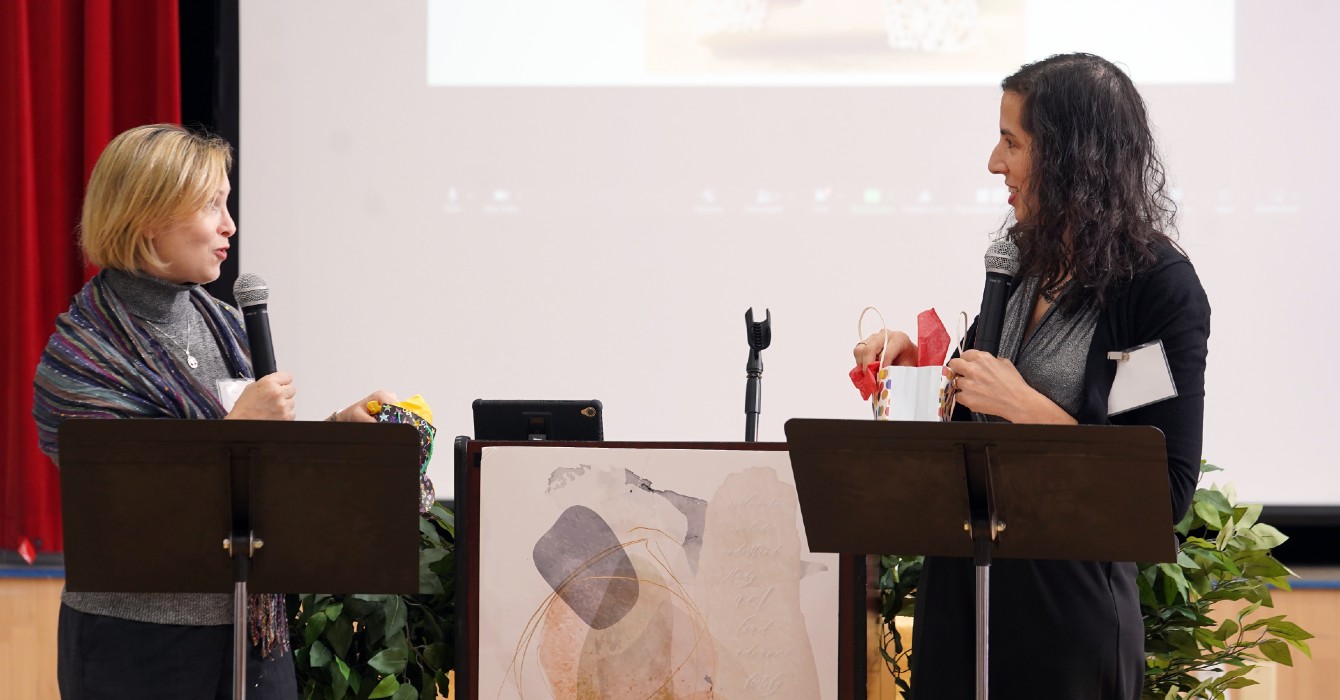Caleb Clardy eyed an old church couched between a string of brownstones and coffee shops. It had that forgotten look, as so much Brooklyn architecture does.
“Let’s try this one.”
That’s about as methodical as Clardy gets. Like Paul, he’s more of a Spirit-led apostle than a strategic church planter. He bumbled around modern-day Ephesus one August morning in 2008, a holy fool wondering where all the Christians were.
Clardy returned that day from his quest to find a place for his home-church to worship defeated by New York’s stoic indifference to his mission. He continued looking, and in the early fall of 2009, the good people of Park Slope Tabernacle, an established Hispanic congregation in the Brooklyn borough, welcomed them in “like family,” Clardy said.
On Sept. 12, 2010, the church celebrated one year of worshipping together. What was once a small Bible study in the Clardy family’s shoe-box apartment is now Trinity Grace Church-Brooklyn, a growing nondenominational church of 125 members that fills the storefront space to maximum capacity.
But unlike fellow nondenominational church plants that work from church-growth strategies, marketing schemes or a seeker-sensitive approach, Trinity Grace Church (TGC) has returned to a traditional parish model grounded in the liturgical practices of the historic church.
Robert Webber, author of “Evangelicals on the Canterbury Trail,” noticed a similar trend with evangelicals back in the 1980s. Many flocked back to high church traditions like Anglicanism, often on the coattails of John Stott. And now, during the more recent debates over social ethics, evangelicals with high church affectations have found a home in Anglican Mission in the Americas circles. There’s a similar path leading back to Rome.
But Trinity Grace Church takes a different tack. They think Catholics are cool, but they’re not becoming Catholic. Or Anglican, for that matter. Or even Presbyterian Church in America, the denomination that supports them more than any other.
“We’ve built relationships with churches that we can theologically agree with but don’t force us to be their church,” Clardy said. “We’re nondenominational, but theologically we stand within the historic tradition of the church: the Apostles’ Creed, the Nicene Creed. We try to guide our congregational life through historic orthodoxy.”
The new, old parish model
Clardy’s church isn’t some rogue enclave in Park Slope. Trinity Grace Church-Brooklyn is just one parish in a network of parishes with a combined membership of 900 to 1,000 people that make up a TGC “body,” with additional parts in Chelsea and on the East and West sides of Manhattan. All five gather six times a year in joint worship, but they emphasize the small, neighborhood parishes.
“A lot of where we are as a whole church movement is trying to be neighborhood-specific,” Clardy said. It’s something Clardy planned with Jon Tyson, TGC’s lead pastor over the Manhattan parishes. “We adopt[ed] a parish model. You don’t get to choose who’s in your parish. You worship with your neighbor, in the community where you live.”
For evangelicals, this isn’t as weird as a New England mainliner speaking in tongues, but it’s close. The polity of many mainline denominations has historically functioned around the parish. Such is not the case in the free church movements within evangelicalism, particularly in the latter half of the 20th century. One need only think of America’s megachurches -- surrounded by endless stretches of parking lots -- to note the contrast to a local church embedded in a particular place.
And really, the language of “nondenominational” is passé in evangelical circles. Church plants today tend to define themselves not so much by their lack of denominational affiliation as their adherence to a church-planting model. Whether it’s Mark Driscoll’s Acts 29 network, the seeker-friendly programs of the Willow Creek model (now waning) or some variation of an emerging church focused on building relationships, church planters think strategically about their ministries in terms of innovative models.
That’s what makes TGC’s return to the parish and liturgical practices so interesting. Their great innovation is ironically quite old, older than the city in which they worship and minister.
Improvising on tradition
Trinity Grace Church's innovation on the traditional church marks its liturgical life from the bottom up. Instead of their weekly small groups reading the latest religious self-help book, TGC’s small groups read Scripture through the lectionary, enter a time of peer confession and end in intercessory prayer for the people and needs of their neighborhood.
“We encourage our church to do things like use the Book of Common Prayer and read through the lectionary readings as their Bible study, because we’re on a shared scriptural journey,” Clardy said.
He also preaches through the liturgical year. He doesn’t follow the lectionary strictly but does structure each sermon series on the Christian calendar.
During Lenten season they did a series called “Cities of God: Walking through the seven churches of Revelation for the season of Lent.” Clardy preached exegetically through the book of Revelation but thematically shaped the sermons by the Christian season. The same is true for Eastertide, Pentecost and during Ordinary time. The methodology reflects a homiletic mashup of liturgical-year and expository series, a style that’s part high, part low, part ... well, it doesn’t really have a name.
It’s the same with worship. They take a lot of old hymns and rework them to new vocal melodies and musical accompaniment. Several are their own originals. The worship ministers from all the parishes meet together weekly with Alf Bishai, a congregant who teaches music theory at New York University, to discuss and plan their music ministries. The instrumentation for worship often includes the pedal steel guitar, accordion, cello, violins, percussion and stand-up bass. “That’s one of the benefits of living in New York,” Clardy said. “We have so many gifted musicians in our congregation.”
The church produced an album called “Without End,” as in “... world without end. Amen, amen.” At moments the music is like a bizarre glimpse into the eschaton -- an apocalyptic vision where Mozart and the Wesley brothers meet Johnny Cash and Coldplay, and they all rock out in some boutique-music venue in the East Village of heaven. It’s a departure from the monotony of the three-chord, two-phrase P&W songs, diluted of musicality and theological richness.
Sharing space with their host church, the Brooklyn congregation of approximately 125 worships Sunday evenings with a hybrid liturgy of creed and confessional prayer, hymns and peace-passing, extended homily and common bread and cup communion -- an adaptation of a traditional order of service.
Bowling alone in New York City
This makes a good deal of sense if one thinks about the context of New York City. The Big Apple is actually a bunch of apple slices, organized by specific neighborhoods.
Clardy and Tyson are attentive to this. “We chose Park Slope because that’s one of the places in the city where people move when they want to lay down roots and stay,” Clardy said. “You get a lot of young people moving to New York, trying to make it in theater or music, but after two years, they’re done. We certainly want to minister to these folks, but as a church we want to lay down roots, too. We’re a church committed to the city, and in New York that means being committed to our specific neighborhoods.”
Tyson believes that despite the façade of ambitious independence that often marks the young and talented who flood New York, there is a deep desire to belong. In a recent article, he engages Robert Putnam’s “Bowling Alone,” suggesting that the loss of formative relationships is the shared experience of Americans, affecting New Yorkers in particular. Despite this social trend, we are “incurably communal,” Tyson said.
He believes program-heavy church models meant to foster a vibrant community often fail to meet their goal. “Despite its good intentions, programmed community often feels like a small-group version of eHarmony. Fill out a life-stage/felt-needs profile, and you are matched up with other people at a similar stage of life and loneliness with the hope that it all works out.”
Tyson also thinks such models fail to acknowledge the fragmentation of contemporary life and the current cultural suspicion toward civic and religious institutions. “There is a deep loneliness and longing to belong, but informally, and in ways the church has not traditionally offered.”
No kingdom without the king
So how do you get lonely, suspicious New Yorkers deeply involved in the church? Trinity Grace Church’s answer to this cultural dilemma is to foster missional “tribes,” as Tyson calls them. Each parish consists of several missional communities aimed at connecting the life of their parish with the life of their neighborhood.
Trinity Grace Church’s missional communities do everything from organizing and performing benefit concerts to participating in neighborhood and citywide social initiatives. The church coordinates with Restore NYC, a nonprofit that serves women escaping the sex-traffic trade. Faith Huckel, Restore’s founder and executive director, and Lance Villio, its operations coordinator, are both church members. Trinity Grace Church’s latest project is a city garden, which provided more than 600 pounds of fresh vegetables last year in Brooklyn’s “food deserts” -- neighborhoods with no sources of fresh food.
“Sometimes Christians talk about church community without really addressing the communities they live in,” Villio said. “Everybody talks about community, but I’d like to think we’re trying to do it.”
Trinity Grace Church’s penchant for civic activism mirrors that of the social gospel movement, but without its theology. “Social justice, yes, but not without the gospel,” Clardy said. “Our generation has the opposite problem of the previous [evangelical] one. We have tons of enthusiasm for social justice, but we’re afraid to take the next step and engage people with the gospel.”
For Clardy, Jesus was not simply the wandering rabbi who taught us to do good but the incarnate Lord who inaugurated the kingdom of God. “Jesus comes announcing the kingdom, and so you can’t take seriously following Jesus without being agents of restoration. But at the same time, you can’t separate that kingdom from Jesus. You can’t have the kingdom without the king.”
‘Let’s give ourselves to this story’
On Easter Sunday, Clardy preached about the stories that envelop our lives. “Mostly, we live in small stories that are just about us. But are we willing to give our lives to a greater story, where we’re united with what we were created to be and with the people we were meant to be with? Let’s give ourselves to this story, because other stories are kind of lame. They don’t have the power of this story -- the power to take us to death and then beyond.”
New York flaunts its own story. Unlike the church’s story, it is flashy, filled with false hopes of independent success and fueled by a vapid desire for cool. Compared with the story told through the sacraments, it is hard to imagine that story co-opting such power for some fleeting end.
The opposite is more likely. Perhaps in a small borough in modern Ephesus, a few 20-somethings will stumble into a storefront church. They’ll eat some bread and drink some wine and maybe think they’re pretty cultured crossing themselves. And without knowing it, they will have been gathered up into something more beautiful than their Broadway dreams.
Questions to consider
Questions to consider:
- How does Trinity Grace Church’s story differ from stories you’ve heard of other church-planting endeavors?
- Does the planting of this church depend on the urban setting of Brooklyn? Could their method of growing a new church with deep roots in tradition apply elsewhere?
- Why do church planting and traditional liturgy seem opposed to one another? What possibilities are opened up by holding them together?
- Why does the blending of tradition and innovation seem more plausible when applied to music than to other contexts?
- How could ecclesial institutions adopt TGC’s entrepreneurial spirit when their memory of their founding is a good deal older?















